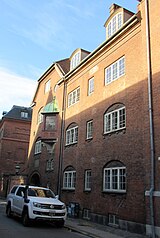
St. Peter's Church is the parish church of the German-speaking community in Copenhagen, Denmark. It is situated at the corner of Nørregade and Sankt Peders Stræde in the city's Latin Quarter. Built as a single-nave church in the mid-15th century, it is the oldest building in central Copenhagen. It is also notable for its extensive complex of sepulchral chapels.

Ernst Heinrich, Baron von Schimmelmann was a German-Danish politician, businessman and patron of the arts.

Gråbrødretorv is a public square in the centre of Copenhagen, Denmark, just off the pedestrian street Strøget.

Ryesgade is a street straddling the border of the Nørrebro and Østerbro districts of Copenhagen, Denmark. Together with Ravnsborggade, its continuation to the south, it forms the backbone of a small neighbourhood bounded by The Lakes to the east, Blegdamsvej to the west, Nørrebrogade to the south and Østerbrogade to the north. The busy artery Fredensgade and the adjacent Fredens Park, effectively separates the Nørrebro and Østerbro portions of Ryesgade from each other. Ryesgade was formerly known for its many second-hand stores of which a few still exist today.

Nørregade is a street in central Copenhagen, Denmark, linking Gammeltorv in the south with Nørre Voldgade in the north. Landmarks in the street include Church of Our Lady, Bispegården, St. Peter's Church and Folketeatret.

The Latin Quarter is a neighbourhood in central Copenhagen, Denmark. It is bounded by Nørregade to the west, Vestergade to the south, Vester Voldgade to the east and Nørre Voldgade to the north. The name refers to the Latin language, which was once widely spoken in and around the University, whose historic home is situated on the other side of Nørregade. Most of the student life has now been relocated to four new campuses but the area is still known for its lively atmosphere with an abundance of boutiques, cafés and night clubs.

Sankt Peder Stræde is a street in central Copenhagen, Denmark. It runs from Nørregade to Jarmers Plads, crossing Larsbjørnsstræde, Teglgårdsstræde and Larslejsstræde on the way. The eponymous St. Peter's Church is located at the beginning of the street, on the corner with Nørregade. Most of its other buildings date from the years after the Copenhagen Fire of 1795. Part of Copenhagen's Latin Quarter, the street is home to several well-known restaurants and shops.

Sankt Petri Schule is a German international private school in Copenhagen. The school, one of the oldest in Denmark dating its origins back to 1575, is located opposite St. Peter's Church, the Lutheran parish church of the German-speaking community in Copenhagen. Sankt Petri Schule is a member of the German Schools Abroad Network DAS.
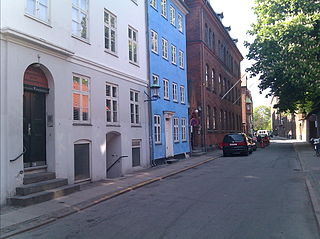
Larslejsstræde is a street in the Latin Quarter of central Copenhagen, Denmark. It links Sankt Peders Stræde with Nørre Voldgade.
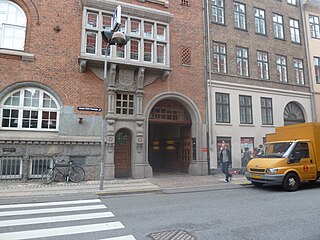
Sankt Petri Passage is a passageway and surrounding mixed-use complex linking Nørregade with Larslejsstræde in central Copenhagen, Denmark. The National Romantic complex was built for the telephone company KTAS in the 1900s and is also known as Telefonhuset. The new name refers to neighbouring St Petri's Church. Current tenants include KVUC as well as several Danish and international companies.

Johan Peter Suhr (1712–1785) was a Danish merchant and founder of the trading house J. P. Suhr & Søn. He served as mayor of Copenhagen under Struense. He was the grandfather of Theodor Suhr.

Nyhavn 11 is an 18th-century property overlooking the Nyhavn canal in central Copenhagen, Denmark. Ludvig Ferdinand Rømer established a sugar refinery on the property in 1653 and it was later continued by changing owners until at least the 1860s. A small figure of a sugar-baker holding a sugar cone is still seen above the gate. The building was listed in the Danish registry of protected buildings and places in 1932. Notable former residents include the general trader Jacob Severin and actors Christian Niemann Rosenkilde, Julie Sødring and Poul Reumert. The lamp manufacturer Louis Poulsen was later based in the building from 1908 to 2006.

Amaliegade 4 is a historic property located in the Frederiksstaden Quarter of central Copenhagen, Denmark. It was built for sugar manufacturer Christian Rønnenkamp in 1829 and was listed on the Danish Registry of Protected Buildings and Places in 1950.
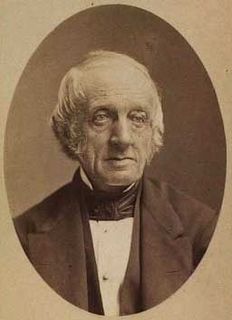
Christian Rønnenkamp was a Danish businessman, landowner and philanthropist. He constructed the listed property at Amaliegade 4 in Copenhagen and owned the estates of Næsbyholm and Bavelse from 1835.

The Andreas Bjørn House is a historic property located at the corner of Strandgade and Bådsmandsstræde in the Christianshavn neighbourhood of Copenhagen, Denmark. It was built for Andreas Bjørn in 1734 and listed on the Danish registry of protected buildings and places in 1918. A sugar refinery named Union House was from 1771 to 1811 located in a now demolished warehouse adjacent to the building by a group of British merchants and plantation owners from St. Croix in the Danish West Indies.
Merløsegaard is a manor house located 9 kilometres north of Ringsted, close to the village of Store Merløse, Holbæk Municipality, some sixty kilometres southwest of Copenhagen, Denmark. Merløsegaard and nearby Bonderup are owned by Den Suhrske Stiftelse. The buildings are now operated as a hotel and event venue.

Larsbjørnsstræde is a street in the Latin Quarter of central Copenhagen, Denmark. It runs from Vestergade in the south to Sankt Peders Stræde in the north, linking Kattesundet to Teglgårdsstræde. Many of the buildings in the street date from the years after the Copenhagen Fire of 1795 and have been listed on the Danish registry of protected buildings and places.
Vilhelm Heinrich Friederichsen was a Danish architect.

Lieutenant General Kjeld Georg Hilligsøe HillingsøSK BVO is a Danish retired general. He is also the father of the actress Ellen Hillingsø.
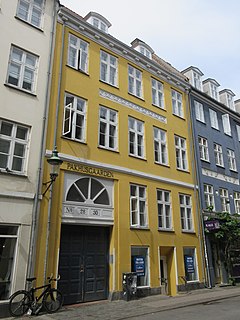
Pakhusgaarden is a Neoclassical property located at Sankt Peders Stræde 28 in the Latin Quarter of central Copenhagen, Denmark. The building was listed on the Danish registry of protected buildings and places in 1959.


